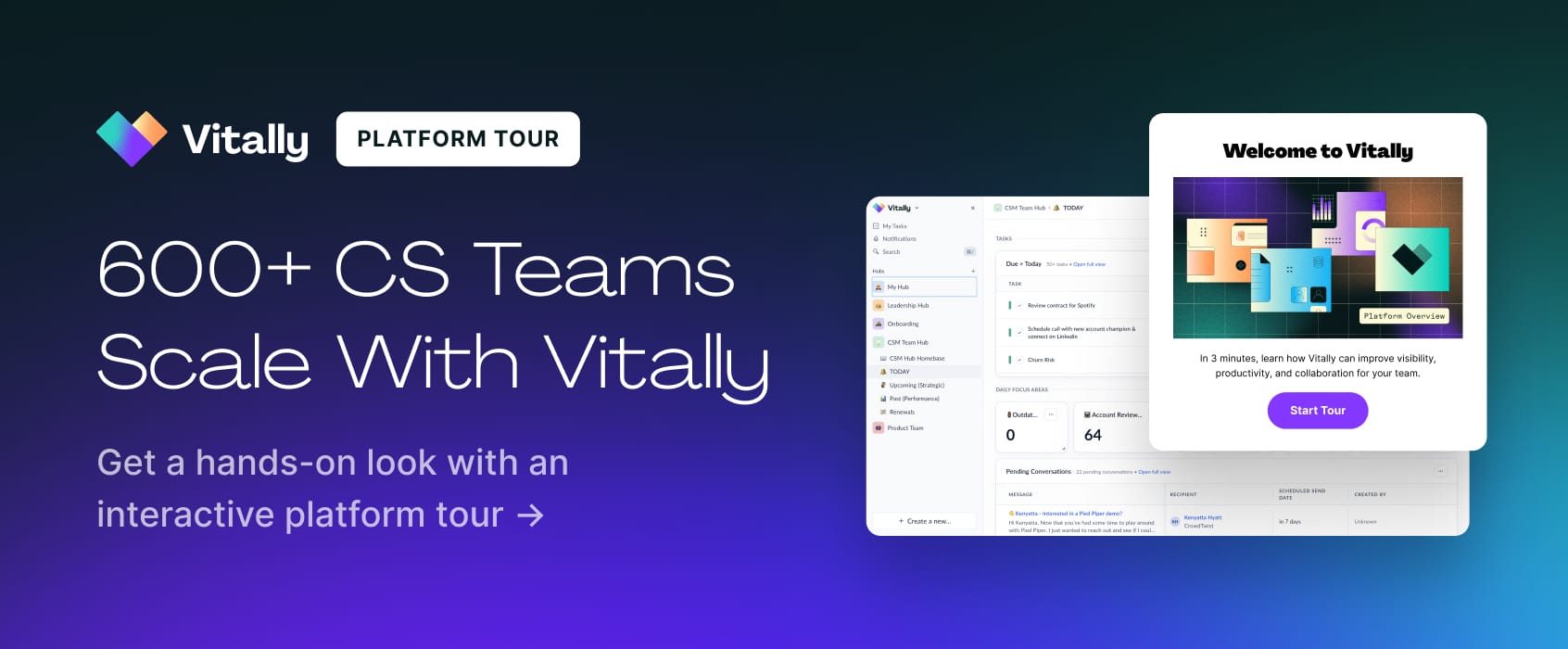
You know what makes us a little sad? Customer Success is still not always seen as the crucial, revenue-driving engine that it is.
So, we’re doing something about it. We’ve created the ultimate cheat sheet to equip modern Customer Success teams with must-know terms and acronyms that’ll help them better communicate with their customers, sound super savvy in front of their teammates, and most importantly, hit their revenue goals.
This glossary covers everything from tried-and-true CS vocabulary to new terms you may not have heard yet. Let us know what you learned (or what we missed) by dropping us a line at hello@vitally.io.
A Glossary of 20 Must-Know Customer Success Terms
1. ARR
Annual Recurring Revenue (ARR) is one of the most important metrics for understanding the long-term health of a SaaS company. ARR is the amount of revenue a company collects from its customers over the course of one fiscal year.
New sales, upsells, renewals, churn, and downgrades are all factors that impact an organization's ARR. For a company that sells multi-year subscriptions, ARR is helpful for forecasting, budgeting, and attracting investors.
2. CAC
Acquiring new customers is no easy feat and requires money — often in the form of marketing dollars and sales team hours. Customer Acquisition Cost (CAC) is the total amount of money that’s spent to win a new logo.
Any sales and marketing expenses that are directly associated with landing a new customer contribute to its CAC. This is an important metric to track because it empowers companies to understand how much they can spend to acquire a new customer while still coming out profitable in the end. Understanding how many customers need to be acquired to hit revenue goals also helps leadership with forecasting and goal setting.
3. Churn
Not every customer will stay a customer forever. Churn is a term that refers to customer attrition (a.k.a. losing a customer) in subscription-based businesses. While some churn is inevitable, top CS organizations will work hard to retain as many ideal customers for as long as possible. Churn has a lot of nuance. Here’s a deeper breakdown of the four types of churn and eight tactics to help prevent it.
4. CRC
It’s just as important to track the cost of keeping a customer as it is to track the cost of acquiring a customer. The Cost to Retain Customers (CRC) is the total amount of money spent to keep customers delighted so they keep paying for your product or service. Elements that factor into CRC include the Customer Success team’s salaries, customer marketing expenses, customer training, and any tools or platforms used to retain existing customers.
5. CSAT
Customer Satisfaction Score (CSAT) is a metric that tells a company how satisfied its customers are with their product or services.
To calculate it, start by asking your customers one simple question: How would you rate your satisfaction with [PRODUCT]? Customers then rank their satisfaction on a 1-5 scale. From there, you divide the number of satisfied customers (people who responded with a 4 or a 5) by the number of survey responses, and multiply this number by 100 to get your percentage of satisfied customers.
For further reading: NPS vs. CSAT: What’s the Difference Between Them and Which One Should You Use?
6. CSM
Customer Success Managers (CSMs) are the individuals on the front lines in your CS organization. CSMs are your customers’ point-of-contact post-sale, and are responsible for things like building and maintaining strong relationships with customers.
One note here: Every company’s CSMs have slightly different responsibilities, but typical responsibilities include onboarding new customers, managing renewals, and owning cross-sells and upsells. The best CSMs are true advocates for their customers, relentlessly making sure that what the broader team is working on will benefit end users.
7. CSP
No one can do their job without the proper tools. Customer Success Platforms (CSPs) are software that enable Customer Success teams to monitor, manage, and optimize customer journeys.
CSPs should be able to provide product usage analytics, customer Health Scores, and customer feedback capabilities. Utilizing a CSP empowers Customer Success teams to increase customer satisfaction, know about upsell opportunities sooner, and reduce churn. Simply put, CSPs help CS teams drive revenue and work more productively.
8. Customer Journey
The customer journey is a term used within most go-to-market organizations to describe the series of unique interactions a customer has with a brand, from their first interaction with a piece of content to their quarterly business reviews.
No customer journey is going to be the same, but patterns in customer experiences often surface and give companies a way to map out their customers’ most common experiences. Journey mapping drives revenue by helping CS leaders understand how to close more new business and increase customer satisfaction and retention for certain segments of customers.
9. Expansion
The modern CSM is no longer just focused on keeping customers happy. With smaller budgets and longer sales cycles in the current B2B landscape, CSMs are expected more than ever to drive revenue for the business, and a key way to do this is through expansion.
Expansion refers to generating additional revenue from existing customers. This includes upselling and cross-selling current customers. Expansion is much more cost-effective than acquiring a new logo, making it crucial for a business’s bottom line.
10. Health Score
A Customer Health Score is an index made up of key performance indicators (KPIs) that’s designed to provide a 30,000-foot view of a customer’s relationship with your product. In short, it answers, “How is [CUSTOMER] doing and feeling lately?”
Health Scores are valuable because they give CSMs an understanding of who their most and least satisfied customers are. This understanding helps predict future customer behavior including renewals, upsells, and churn.

11. KPIs
Every role in a company has Key Performance Indicators (KPIs). KPIs are quantifiable measurements of strategic business objectives. These numbers allow CSMs and CS leadership to track organizational, departmental, and individual employee effectiveness.
12. LTV
Customer Lifetime Value (LTV or CLTV) is a metric that tells an organization how much revenue a customer could reasonably generate for the business throughout their customer life cycle. LTV is a crucial metric because it effectively measures customer loyalty, which drives revenue, reduces churn, decreases customer acquisition costs, and informs strategic business planning.
13. NPS
Net Promoter Score (NPS) is a metric that broadly measures the customer experience. The goal of NPS is to understand the percentage of your customers who are business promoters vs. business detractors.
NPS is measured by asking this question: What is the likelihood that you would recommend our product/service to someone else? Customers answer using a 0-10 scale. The ones who select a 9 or 10 are categorized as “promoters,” while customers who choose a 0–6 are categorized as “detractors.” To calculate NPS, simply take the percentage of promoters who answered your survey and subtract it by the percentage of detractors.
Here’s some more information on calculating your NPS and proactively working to raise it.
14. NRR
Net Revenue Retention (NRR) is one of the most common KPIs tracked in Customer Success organizations. NRR calculates the percentage of revenue retained from existing customers in a specific time period, taking into account upgrades, downgrades, upsells, and churn.
The goal of measuring NRR is to understand what percentage of your customers are remaining loyal, and whether or not the revenue a team manages is expanding at a faster rate than people are churning.
The formula to calculate NRR is: (Starting MRR* + Change in MRR) / Starting MRR.
*MRR = Monthly Revenue Retention
15. Product Usage Rate
Customers that last are typically the ones using your product on a consistent basis. Product Usage Rate is a measurement of how often users engage with your product in a meaningful way. This is an important metric for CS teams because usage rate allows you to identify power users that are ripe for upsell, as well as non-adopters who could possibly churn.
16. QBR/EBR
Quarterly Business Reviews (QBRs), sometimes referred to as Executive Business Reviews (EBRs), are key touchpoints in the customer journey.
QBRs are meetings between a Customer Success Manager and key stakeholders at an account. The purpose of a QBR is to review the previous quarter's goals and milestones. QBRs are unique opportunities for the CSM to have all (or most) of the key stakeholders in the room and demonstrate their position as strategic advisors. Prepping for your next QBR? Here’s a QBR prep template to help you get the most out of it.
17. Renewal
Renewal is when an existing customer chooses to re-up their subscription at the end of their contract. The current B2B cost-cutting trend means that customer renewal is critical to your business’ success. However, renewals don’t happen without putting in the work. We created an ungated guide and checklist to help you eliminate stress and secure more renewals if you’re interested.
18. Scaled CS
Scaled Customer Success is one of the newer terms in this glossary and has been generating a lot of buzz over the past few years. Scaled CS is a one-to-many approach to Customer Success that brings together both tech-touch and high-touch Customer Success.
This blended approach enables organizations to operate with less overhead while still providing a personalized customer experience. It’s a heady topic for sure, but this scaled CS blog post breaks it down well.
19. Upsell
Spoiler alert, Customer Success has some selling involved! Upselling means you’ve gotten an existing customer to purchase more from you, whether that’s investing in a higher tier of your product offering, buying more seats, or doing something else. Upselling has become more important post-pandemic as acquiring new customers has become increasingly difficult.
20. YoY Retention
Year over Year Retention is the percentage of a company’s existing customers who remain customers from one year to the next. This metric is critical in understanding the lifetime value of a customer and forecasting revenue.
Combing Through These Terms Is Only the Beginning
To be the best, you have to be a constant student of your craft, even if you’ve been in the biz for 20+ years. Having a deep understanding of these terms is vital to becoming (and remaining) a successful, modern CS pro.
Want to learn more about Customer Success excellence in 2024? Don’t stop at this glossary. Peruse Vitally’s Success Network, a community-focused content hub filled with advice and strategies from top CS voices.









